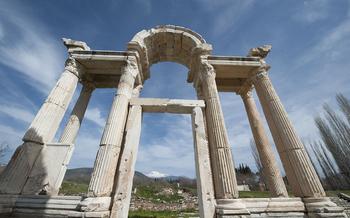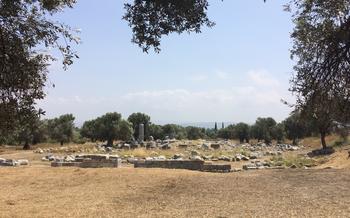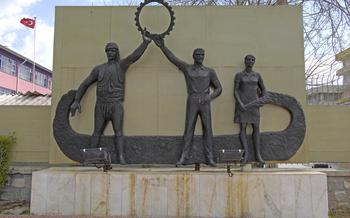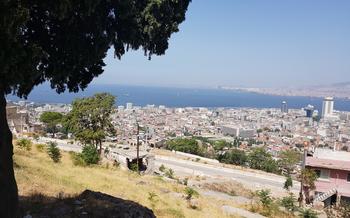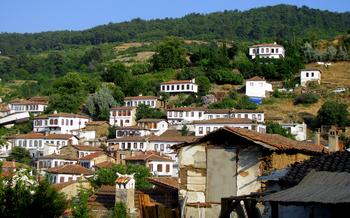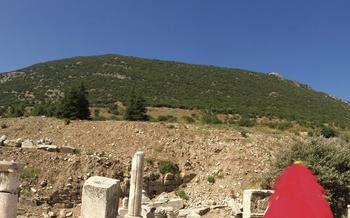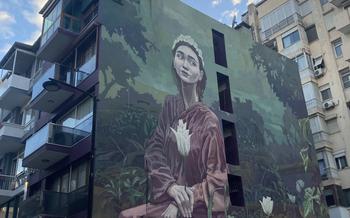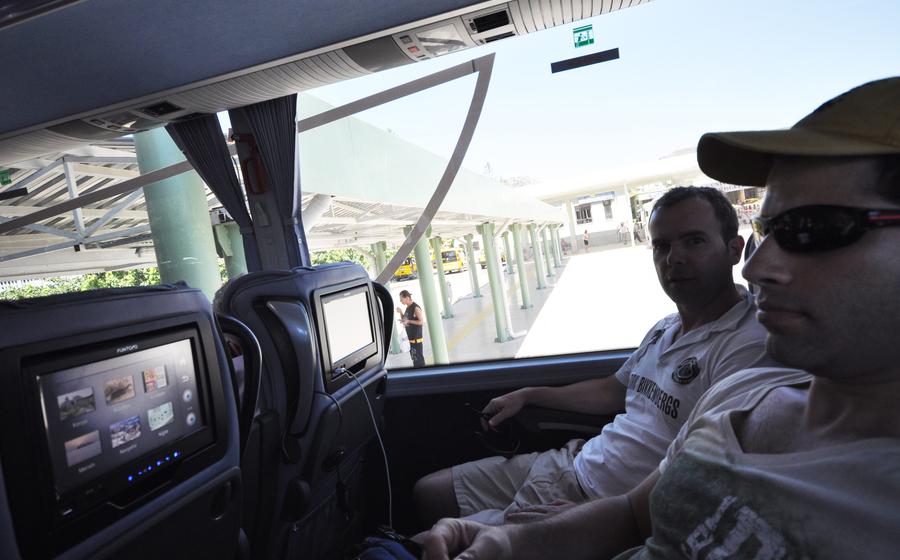
Metropolis Ancient City
- A Journey Through Time: Unveiling Metropolis Ancient City
- The Magnificent Theater: A Stage for Ancient Dramas
- The Temple of Apollo: A Sanctuary for the Sun God
- The Agora: A Bustling Marketplace and Social Hub
- The Gymnasium: Training Grounds for Mind and Body
- The Roman Baths: A Sanctuary of Relaxation and Hygiene
- The Necropolis: A City of the Dead
- Around Metropolis: Exploring the Region's Hidden Gems
- Turkish Delights: A Culinary Journey in İzmir
- The Vibrant City of İzmir: A Modern Metropolis with Ancient Roots
- Practical Tips for a Seamless Visit to Metropolis
- Events and Festivals: Bringing History to Life
- Insider Tip: Hidden Gems and Off-the-Beaten-Path Explorations
A Journey Through Time: Unveiling Metropolis Ancient City
Nestled amidst the serene hills of western Turkey, Metropolis Ancient City beckons travelers to embark on a journey through time. This remarkably well-preserved archaeological site offers a glimpse into the grandeur of ancient Greek and Roman civilizations. Founded in the 4th century BC, Metropolis flourished as a thriving city-state, leaving behind a legacy of impressive monuments, theaters, temples, and public buildings that stand as testaments to its glorious past.
Conveniently located just a short distance from the modern city of İzmir, Metropolis is easily accessible by car or public transportation. The ancient city is open to visitors year-round, with the best time to visit being during the shoulder seasons (spring and autumn) when the weather is pleasant and the crowds are smaller. Entrance fees are nominal, and operating hours vary depending on the season, so it's advisable to check the official website or local tourist information centers for up-to-date information.
The Magnificent Theater: A Stage for Ancient Dramas
The theater of Metropolis, a magnificent spectacle carved into the hillside, stands as a testament to the city's cultural and artistic legacy. Constructed in the 3rd century BC, this architectural marvel boasts a seating capacity of over 20,000 spectators, making it one of the largest theaters in the ancient world. Its impressive acoustics, achieved through careful design and positioning, ensured that even the faintest whisper could be heard throughout the vast auditorium.
The theater's stage, adorned with intricate bas-reliefs and sculptures, once played host to a variety of performances, from grand tragedies and comedies to musical concerts and religious ceremonies. Thespians graced this stage, captivating audiences with their powerful performances, while musicians filled the air with enchanting melodies.
Over the centuries, the theater has undergone numerous renovations and restorations, preserving its grandeur and ensuring its continued use. Today, it serves as a venue for cultural events and performances, allowing visitors to experience the magic and atmosphere of ancient Greek theater firsthand.
The Temple of Apollo: A Sanctuary for the Sun God
The Temple of Apollo, a magnificent structure dedicated to the revered sun god, stands as a testament to the religious fervor and architectural prowess of ancient Metropolis. Excavations have revealed the temple's rich history, dating back to the 4th century BC. Its imposing presence and intricate design elements evoke a sense of awe and wonder.
Built in the Ionic style, the temple features a rectangular layout with a colonnade of stately columns encircling the cella, the innermost chamber that once housed the sacred statue of Apollo. The temple's facade boasts an elaborate pediment, adorned with exquisite sculptures depicting scenes from Greek mythology. These intricate carvings narrate tales of divine interventions and heroic deeds, offering a glimpse into the beliefs and values held dear by the ancient inhabitants of Metropolis.
During its heyday, the Temple of Apollo served as a central hub for religious ceremonies, festivals, and rituals honoring the sun god. Devotees from far and wide flocked to this sacred site to seek divine blessings, offer sacrifices, and participate in grand celebrations. The temple's grandeur and opulence reflected the deep reverence and devotion that the people of Metropolis held for their patron deity.
Today, the Temple of Apollo stands as a poignant reminder of the city's illustrious past and its enduring connection to the divine. Although time and natural elements have taken their toll, the temple's foundations, columns, and architectural fragments remain, inviting visitors to step back in time and imagine the grandeur that once graced this sacred space. Ongoing restoration efforts aim to preserve and protect this invaluable heritage, ensuring that the Temple of Apollo continues to captivate and inspire generations to come.
The Agora: A Bustling Marketplace and Social Hub
The agora, the bustling heart of ancient Metropolis, was a place of commerce, social interaction, and civic life. This central marketplace served as a hub for economic and social activities, where locals and visitors gathered to trade goods, exchange ideas, and conduct public affairs.
The agora's layout was carefully designed to facilitate a variety of activities. Shops and stalls lined the perimeter, offering a diverse selection of goods ranging from fresh produce to imported luxuries. Merchants displayed their wares, enticing passersby with vibrant colors and exotic aromas.
In addition to its commercial function, the agora served as a social hub for the community. Public buildings, such as the bouleuterion (council chamber) and the prytaneion (government building), were located within the agora, providing venues for political discussions and civic meetings.
The agora was also a place of entertainment and leisure. It hosted performances, public speeches, and religious ceremonies, drawing crowds from across the city. The vibrant atmosphere and lively interactions made the agora a beloved gathering place for the citizens of Metropolis.
Today, the remains of the agora offer a glimpse into the bustling marketplace of ancient times. While many structures have been reduced to ruins, the foundations of shops and public buildings can still be seen, providing clues to the layout and functions of this important urban space.
The Gymnasium: Training Grounds for Mind and Body
In ancient Greek culture, physical fitness was considered paramount for both the body and the mind. The gymnasium, an essential component of every major ancient Greek city, served as a training ground for both physical and intellectual pursuits. Metropolis' gymnasium, situated in the heart of the city, is no exception.
The gymnasium, constructed during the Hellenistic period, was a large rectangular building with a spacious central courtyard. The courtyard was surrounded by a colonnade, providing shelter and shade for athletes and students. Within the courtyard were facilities for various sports and exercises, including a running track, a wrestling arena, and a jumping pit. Along the perimeter of the courtyard were rooms for bathing, changing, and storing equipment.
The gymnasium was not only a place for physical training but also a center for intellectual pursuits. There were dedicated rooms for lectures, debates, and philosophical discussions. The gymnasium's library housed a collection of scrolls and manuscripts, providing a wealth of knowledge for those seeking to expand their minds.
Today, the gymnasium of Metropolis lies in ruins, but its grand scale and impressive architecture still evoke the spirit of this ancient institution. Ongoing excavations continue to uncover new insights into the daily life and activities that took place within these walls.
The Roman Baths: A Sanctuary of Relaxation and Hygiene
The Roman Baths in Metropolis, İzmir, stand as a testament to the ancient Roman civilization's emphasis on hygiene and bathing rituals. These elaborate facilities offered a sacred space for relaxation, rejuvenation, and social interaction. Entering the baths, visitors would be greeted by an impressive architectural ensemble, featuring separate sections for men and women.
The baths were designed with a focus on functionality and comfort, incorporating various features to enhance the bathing experience. Heated floors and walls, fueled by an ingenious hypocaust system, ensured a warm and inviting ambiance. Water was meticulously supplied through an intricate network of aqueducts, providing a steady flow for the various bathing pools and fountains.
Stepping into the frigidarium, bathers would begin their journey with a refreshing plunge into the cold water pool. This invigorating experience was followed by a visit to the tepidarium, a moderately warm room that served as a transition between the cold and hot sections. The highlight of the bathing ritual was undoubtedly the caldarium, where bathers could immerse themselves in steaming hot water, easing their muscles and promoting relaxation.
Beyond their practical purpose, the Roman Baths also served as a social hub, where members of the community could gather, socialize, and engage in philosophical discussions. The presence of intricate mosaics, decorative elements, and sculpted statues added to the luxurious and opulent atmosphere of these bathing establishments.
Today, the Roman Baths in Metropolis, although in ruins, offer a glimpse into the advanced bathing culture of the ancient Romans. Visitors can explore the well-preserved remains of the pools, heating systems, and changing rooms, marveling at the ingenuity and sophistication of this once-thriving bathing complex.
The Necropolis: A City of the Dead
On the outskirts of Metropolis lies the necropolis, an ancient cemetery that offers a glimpse into the burial practices and beliefs of the city's inhabitants. Spread across a vast expanse, the necropolis features a variety of tombs and funerary monuments, each telling a unique story about the lives and deaths of those laid to rest here.
From simple pit graves to elaborate rock-cut tombs, the necropolis showcases the diverse burial customs of Metropolis. Some tombs are adorned with intricate carvings and inscriptions, providing insights into the lives and achievements of the deceased. Others contain personal belongings and offerings, revealing glimpses of their hopes and fears for the afterlife.
Notable among the funerary monuments are the impressive mausoleums, which were built to honor wealthy and influential individuals. These grand structures often feature multiple chambers, elaborate facades, and decorative elements that reflect the status and power of the deceased.
The necropolis is not only a place of remembrance but also a valuable source of archaeological information. Ongoing excavations have uncovered a wealth of artifacts, including jewelry, pottery, and coins, which shed light on the daily lives, trade connections, and cultural influences of ancient Metropolis.
As you wander through the ancient cemetery, you can't help but feel a sense of awe and respect for the people who once called this city their home. The necropolis serves as a poignant reminder of the cycle of life and death and the enduring legacy of Metropolis, a city that continues to captivate visitors with its rich history and timeless beauty.
Around Metropolis: Exploring the Region's Hidden Gems
Beyond the ancient ruins of Metropolis, the surrounding region offers a wealth of hidden gems and unexplored treasures. A short drive from the ancient city, you can discover a network of well-preserved Roman aqueducts that once supplied water to the metropolis. These impressive structures, with their towering arches and intricate engineering, stand as a testament to the ingenuity of the ancient Romans.
Nature enthusiasts will find solace in the nearby Mount Yamanlar National Park, a haven of lush forests, cascading waterfalls, and breathtaking panoramic views. The park provides ample opportunities for hiking, camping, and wildlife spotting, making it an ideal escape from the urban bustle.
For a taste of authentic Turkish village life, venture to the picturesque village of Birgi, located just a few kilometers from Metropolis. With its charming cobblestone streets, traditional Ottoman houses, and vibrant local markets, Birgi offers a glimpse into the region's rich cultural heritage. Don't miss the opportunity to sample the village's renowned grape molasses, a local delicacy produced using traditional methods.
History buffs can embark on a day trip to the ancient city of Ephesus, one of the best-preserved Greco-Roman cities in the world. Explore its magnificent ruins, including the awe-inspiring Library of Celsus and the Great Theater, and step back in time as you marvel at the grandeur of this once-thriving metropolis.
These are just a few of the many hidden gems that await you in the region surrounding Metropolis. Whether you seek adventure, history, or tranquility, the diverse landscapes and rich cultural heritage of this area promise an unforgettable journey.
Turkish Delights: A Culinary Journey in İzmir
Izmir, the culinary heart of Turkey, offers a tantalizing array of flavors and aromas that will delight your taste buds.
From traditional Turkish dishes to modern fusion cuisine, İzmir's culinary scene is a vibrant tapestry of culinary experiences.
Start your culinary adventure with gözleme, a savory flatbread stuffed with your choice of fillings, such as cheese, spinach, or minced meat.
For a taste of the sea, indulge in balık ekmek, a grilled fish sandwich served with fresh greens and tangy lemon wedges.
No visit to İzmir is complete without sampling the city's famous kumru, a toasted sandwich filled with sausage, cheese, tomatoes, and cucumbers, all drizzled with a spicy tomato sauce.
For a sweet treat, try lokma, bite-sized balls of fried dough soaked in syrup, or pişmaniye, a delicate cotton candy-like dessert made from roasted flour and sugar.
To delve deeper into the culinary delights of İzmir, join a cooking class and learn the secrets of Turkish cuisine from local experts.
Indulge in the vibrant flavors of the local cuisine, savor the freshness of seasonal ingredients, and embrace the warm hospitality that defines İzmir's dining experience.
The Vibrant City of İzmir: A Modern Metropolis with Ancient Roots
İzmir, the modern metropolis where the ancient city of Metropolis lies, is a vibrant and bustling city that seamlessly blends its rich history with a modern and cosmopolitan lifestyle. As the third-largest city in Turkey, İzmir boasts a diverse array of cultural attractions, landmarks, and experiences, making it a captivating destination for travelers seeking a harmonious blend of antiquity and modernity.
In the heart of İzmir, visitors can explore the historic Kemeraltı Bazaar, a vibrant marketplace that has been a hub of trade and commerce for centuries. Here, they can wander through narrow cobbled streets, marvel at the intricate architecture of centuries-old shops, and indulge in a delightful array of local delicacies, from freshly baked pastries to aromatic spices.
History buffs will be captivated by the city's numerous museums, including the İzmir Archaeology Museum, which houses an impressive collection of artifacts from the ancient city of Metropolis and the surrounding region. The museum offers a glimpse into the rich cultural heritage of İzmir, showcasing the city's role as a significant center of trade and culture throughout history.
For those seeking a taste of modern Turkish culture, İzmir offers a vibrant nightlife scene, with an array of bars, clubs, and restaurants to choose from. The city's waterfront promenade, the Kordon, is a popular gathering spot, where locals and visitors alike can enjoy a leisurely stroll, savor delicious seafood at one of the many restaurants, or simply soak in the breathtaking views of the Aegean Sea.
Practical Tips for a Seamless Visit to Metropolis
Essential Travel Tips and Advice: - Plan Ahead: Research the site, choose the right time to visit, and book your tickets in advance. - Comfortable Shoes: The ancient city involves a lot of walking on uneven surfaces, so comfortable footwear is a must. - Stay Hydrated: Bring a refillable water bottle, as there are limited water sources within the ruins.
Suggested Itineraries and Tour Options: - Self-Guided Tour: Explore at your own pace with a map and guidebook. - Guided Tour: Join an organized tour for in-depth historical insights. - Half-Day or Full-Day: Plan your visit based on your interests and time constraints.
Photography Tips and Guidelines: - Capture the Light: Visit during the golden hours (sunrise and sunset) for stunning photos. - Wide-Angle Lens: Bring a wide-angle lens to capture the vastness of the ruins. - Tripod: Use a tripod for stability, especially in low-light conditions.
Respecting Local Customs and Traditions: - Dress Code: Dress respectfully, covering your shoulders and knees. - Noise Level: Be mindful of noise levels, as the site is revered for its historical significance. - Photography Etiquette: Ask permission before photographing local people.
Events and Festivals: Bringing History to Life
Metropolis comes alive during its annual cultural events and festivals. These celebrations offer a unique opportunity to experience the ancient Greek traditions and customs that once filled the streets of this vibrant city.
The most notable event is the Metropolis Theater Festival, held during the summer months. This festival showcases a variety of performances, including ancient Greek dramas, concerts, and dance recitals, all staged within the stunning backdrop of the ancient theater.
Other popular events include the Metropolis Food and Wine Festival, which celebrates the region's culinary heritage with traditional dishes, local wines, and cooking demonstrations. The Metropolis Arts Festival showcases the work of local artists and artisans, with exhibitions, workshops, and live demonstrations.
Attending these events is a fantastic way to immerse yourself in the history and culture of Metropolis. Whether you're a theater enthusiast, a foodie, or simply looking for a unique and authentic experience, you're sure to find something to enjoy at one of these vibrant festivals.
Insider Tip: For a truly immersive experience, plan your visit to Metropolis around one of its annual festivals. Check the official website or local tourism offices for event dates and schedules to ensure you don't miss out on these special celebrations.
Insider Tip: Hidden Gems and Off-the-Beaten-Path Explorations
Beyond the main attractions, Metropolis offers a treasure trove of hidden gems waiting to be discovered by curious travelers. Venture off the beaten path to uncover lesser-known sites and unique experiences that will leave you with lasting memories.
Explore the outskirts of the ancient city to discover hidden tombs and ruins that have yet to be fully excavated. These forgotten remnants of the past offer a glimpse into the everyday lives of Metropolis's inhabitants.
For a truly immersive experience, take a guided tour led by local experts who can share fascinating stories and insights about the city's history and culture. They can lead you to secret spots with breathtaking views, perfect for capturing stunning photographs.
Don't miss the opportunity to interact with local artisans and craftsmen who continue to practice traditional techniques passed down through generations. From pottery and weaving to metalworking and jewelry making, their workshops offer a glimpse into the vibrant artistic heritage of the region.
Immerse yourself in the local culture by visiting traditional villages nestled amidst picturesque landscapes. These villages offer a glimpse into the authentic Turkish way of life, with friendly locals welcoming visitors with open arms.
Indulge in culinary delights by venturing into local markets and savoring the flavors of traditional Turkish cuisine. From freshly baked bread and gözleme to succulent kebabs and aromatic spices, the region offers a feast for the senses.
Remember to respect local customs and traditions as you explore Metropolis and its surroundings. Dress modestly, especially when visiting religious sites, and be mindful of noise levels to preserve the tranquility of the ancient city.
With a little curiosity and a willingness to explore beyond the obvious, you'll uncover the hidden treasures of Metropolis, creating a truly memorable and enriching travel experience.
